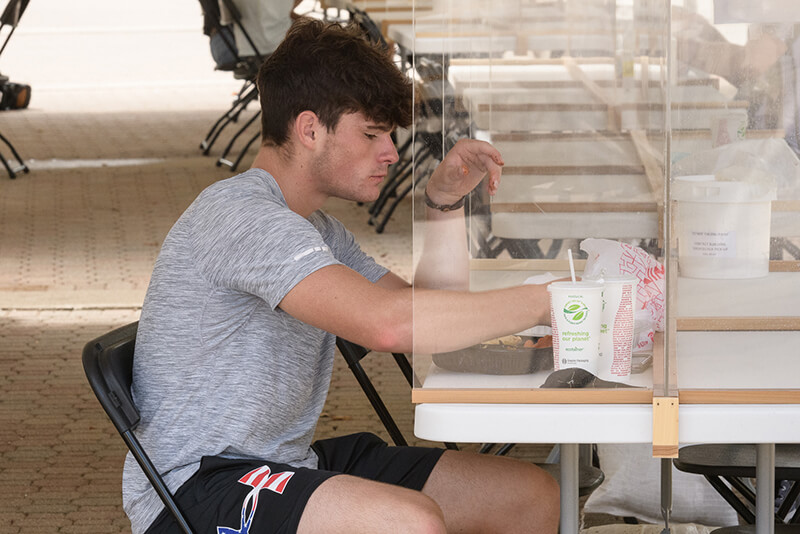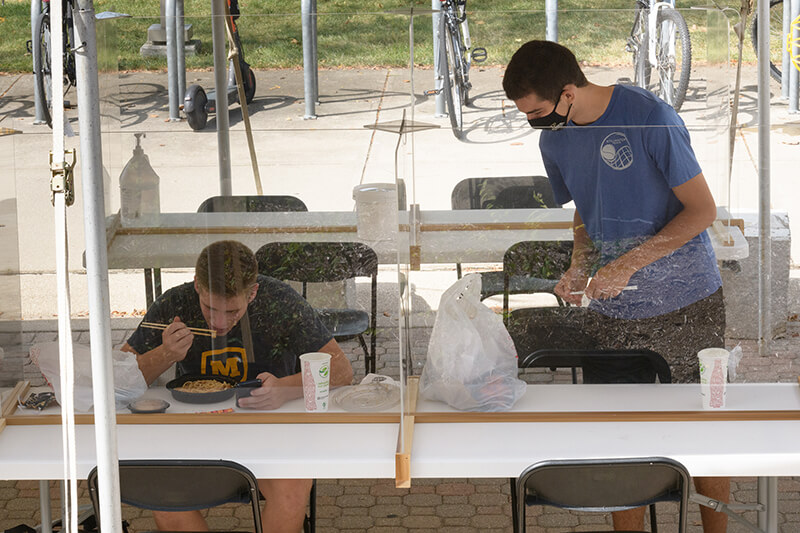September 3, 2020
Outdoor study, dining tents added as part of Protect Purdue effort

A Purdue student uses one of the 37 study and dining tents now dotting campus. The additional open-air spaces give students, faculty and staff greater options this semester for study, dining and work as part of the Protect Purdue Plan to de-densify gathering spaces in reducing spread of COVID-19. (Purdue photo/John Underwood)
New campus study spaces designed to encourage social distancing, de-densification
WEST LAFAYETTE, Ind. - On a sunny, bright August afternoon, industrial engineering major Sarah Laplena was enjoying the shade and the outdoors on the Memorial Mall between classes, provided through one of the 37 study and dining open-air tents now dotting the Purdue University campus.
Each space is equipped with hand sanitizer, disinfecting wipes and walls of plexiglass, offering protection and the proper social distancing for users in this new normal of a college campus in the time of the COVID-19 pandemic.
“The outdoor study tents are an excellent idea, the Wi-Fi is strong and people seem to be using them,” says Laplena, a Purdue senior from Rochester, Michigan. “I’m just really happy to be back on campus, especially since this is my senior year. And everyone seems to be doing the right thing.”
The additional spaces are available across campus to give students, faculty and staff greater options for study, dining and work as part of the University’s comprehensive Protect Purdue Plan to de-densify gathering spaces in reducing the spread of COVID-19.
The 16 outdoor study tents and 21 dining tents are the most visible and popular new spaces as part of the de-densification plan. Dining tents are located near dining halls and retail dining vendors. The open-air study spaces can be found on this map or marked with the tent symbol on this campus map. Most tents are open daily from 6:30 a.m. to 11 p.m., and the tents vary in size and capacity. In total, they add more than 1,500 spaces for students and others.
Some tents have been installed at the request of campus departments or organizations and are labeled as such on the campus map. Hours of operation, however, may differ from the general tents. For the most current list of all study spaces on campus, go here.
“Purdue is making every effort to provide open-air study spaces and services to our community while taking the proper preventive steps to minimize the impact of COVID-19 on our students, faculty and staff,” said Beth McNeil, dean and the Esther Ellis Norton Professor of Library Science and School of Information Studies at Purdue.
“Working with our colleagues in Physical Facilities and Student Life, the outdoor tents allow us to add more capacity, recognizing that many indoor locations are unavailable or have reduced capacity because of our de-densification efforts to provide healthy and safe in-person learning.”
To be safe and considerate of others, outdoor tent users are asked to clean their area with disinfectant wipes before and after use, and to use hand sanitizer as needed, said Ryan Gallagher, senior director of Facilities Operations at Purdue. Custodians disinfect the tables and plexiglass barriers in the tents each night.
 Students take advantage of the shade provided by study tents placed on the Purdue University campus. Each space is designed to provide protective measures against the COVID-19 virus. (Purdue University Photo/John Underwood)
Download image
Students take advantage of the shade provided by study tents placed on the Purdue University campus. Each space is designed to provide protective measures against the COVID-19 virus. (Purdue University Photo/John Underwood)
Download image
The tents, however, are off limits during inclement weather.
“Dining tents are located near dining halls and retail dining vendors, while the study tents are spread across campus, with the majority in the core academic area of campus,” Gallagher said. “Users must wear their face masks correctly, removing them only to eat or drink.”
The Hicks Undergraduate Library; Wilmeth Active Learning Center; Parrish Library; Aviation Technology and Transportation Library; Mathematical Sciences Library; the Humanities, Social Science, and Education (HSSE) Library; and the Veterinary Medicine Library are open for study, Wi-Fi and computer use.
While many services are available in person this fall, including book order pickup at all locations, Libraries remains committed to offering expanded virtual services, including a growing collection of electronic resources and the ability to chat with a librarian online.
Detailed in the Protect Purdue Plan, the University established a bold target to significantly de-densify classrooms, study and workspaces, and better protect the health and safety of a campus community of more than 50,000 students, faculty and staff. That strategy is in addition to the effort to de-densify other campus spaces, reducing learning-space occupancies by 50% and limiting occupancy for large classrooms to no more than 150 students.
At the start of the semester, space between instructor and student now is a minimum of 10 feet, and Purdue purchased an estimated five miles of plexiglass for additional protection and safe social distancing in classes, libraries, offices, laboratories and other academic and research spaces.
Media Contact: Jim Bush, 765-336-1909, jsbush@purdue.edu
Sources: Beth McNeil, memcneil@purdue.edu, 765-494-2902
Ryan Gallagher, ryan@purdue.edu, 765-494-8003

